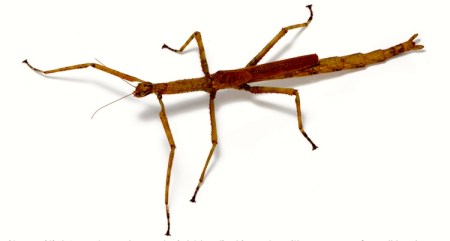Today’s morning name: stick insect (creatures from my insect-collecting childhood):

(#1) The strong stick insect, Anchiale briareus
Fascinating creatures, with long bodies and camouflage coloration — brown like sticks, green like leaves.
Probably in my mind from a Facebook query by Georgia Morgan on the 30th about a long-bodied brownish insect that had turned up on a screen in her Brattleboro VT house. Which, as it turned out, was a tree cricket, not a stick insect.
A celebrated kid riddle:
Q: What’s long, brown, and sticky?
A: A stick! (riddler chortles at their own cleverness)
(Or: A stick insect!)
From Wikipedia on stick insects:
The Phasmatodea (also known as Phasmida or Phasmatoptera) are an order of insects, whose members are variously known as stick insects in Europe and Australasia; stick-bugs, walking sticks or bug sticks in the United States and Canada; or as phasmids, ghost insects or leaf insects (generally the family Phylliidae). The group’s name is derived from the Ancient Greek φάσμα phasma, meaning an apparition or phantom, referring to the resemblance of many species to sticks or leaves. Their natural camouflage makes them difficult for predators to detect, but many species have a secondary line of defence in the form of startle displays, spines or toxic secretions. The genus Phobaeticus includes the world’s longest insects.
(#2) A giant Australian stick insect, Ctenomorpha gargantuaMembers of the order are found in all continents except Antarctica, but they are most abundant in the tropics and subtropics.
A green one:

(#3) The unarmed stick insect (Acanthoxyla inermis)
On to the insect on Georgia’s screen (in a photo she took):
From Wikipedia:
Tree crickets are insects of order Orthoptera [also taking in grasshoppers and locusts]. These crickets are in the subfamily Oecanthinae of the family Gryllidae. This subfamily contains seven genera.
They live in trees and shrubs, for which they are well camouflaged [most are green, some are brown]. These crickets are nocturnal and can be found on every continent except Antarctica.
In Europe Tree Crickets have been expanding northwards and had reached the island of Jersey in the Channel Islands by 2010 and in August 2015 the first population was found in mainland England at Dungeness in Kent, where hundreds of males were present. [#3 is a British stick insect]
More specifically, from the Songs of Insects site:

(#5) A two-spotted tree cricket (Neoxabea bipunctata)
The Two-spotted Tree Cricket is an arboreal species attracted to dense vegetation, especially thick stands of young trees, where males sing from the underside of broad leaves. Generally stays well off the ground, making this species difficult to observe or collect. This is the largest tree cricket in our area, however, and they can be plentiful. It is easily recognized by its reddish body with tan wings and legs. The common name is derived from the fact that females usually have two prominent dark spots on their wings [as in #4].

(#6) Distribution of the two-spotted tree cricket
The map has the insect just barely in southern Massachusetts, but Georgia Morgan’s well north of there, in Vermont. Apparently, just as the European tree crickets have been extending their range north (presumably as a consequence of a warming climate), so are the American tree crickets.
Field crickets. Yes, tree crickets don’t look much the everyday crickets that sing on summer nights and get into houses. The larger family, from Wikipedia:
Crickets (also known as “true crickets”), of the family Gryllidae, are insects related to [UK] bush crickets [US katydids, in the family Tettigoniidae], and, more distantly, to grasshoppers.
… Crickets are mainly nocturnal, and are best known for the loud, persistent, chirping song of males trying to attract females
And then the subfamily of your everyday crickets (from Wikipedia):

(#6) A black field cricket, Gryllus assimilis
Field crickets … are in subfamily Gryllinae of family Gryllidae [tree crickets are in the subfamily Oecanthinae].
… “Field cricket” is a common name for Gryllus assimilis, G. bimaculatus, G. campestris, G. firmus, G. pennsylvanicus, G. rubens, and G. texensis, along with other members of various genera including Acheta, Gryllodes, Gryllus, and Teleogryllus. Acheta domesticus, the House cricket, and Gryllus bimaculatus are raised in captivity for use as pets.


September 1, 2018 at 3:18 pm |
I would find “walking sticks” every August on the leaves of the staghorn sumac bushes that grew along the Olentangy by the bikepath behind OSU Hospitals. I used to walk along the river there with my Airedale.